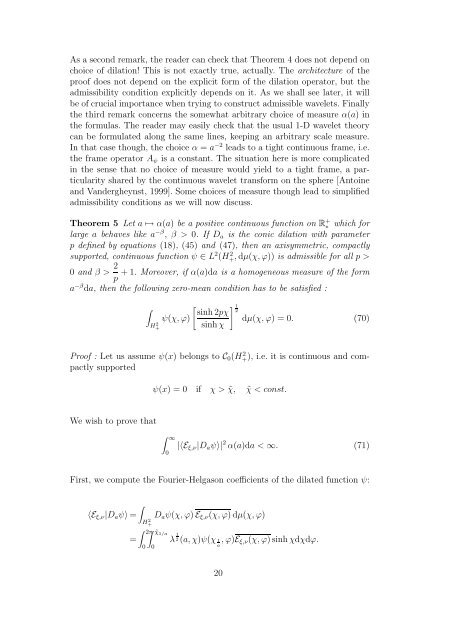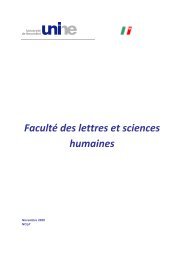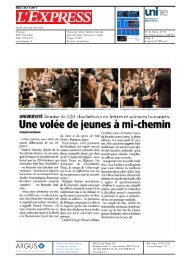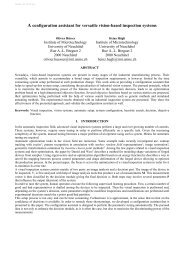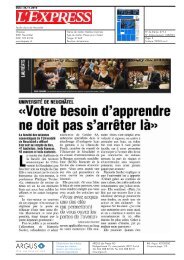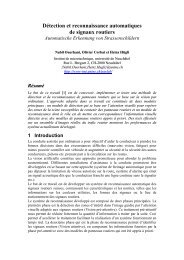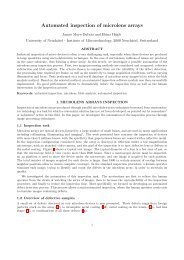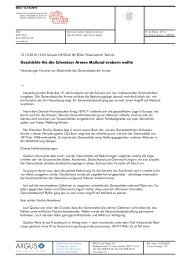Continuous Wavelet Transform on the Hyperboloid - Université de ...
Continuous Wavelet Transform on the Hyperboloid - Université de ...
Continuous Wavelet Transform on the Hyperboloid - Université de ...
You also want an ePaper? Increase the reach of your titles
YUMPU automatically turns print PDFs into web optimized ePapers that Google loves.
As a sec<strong>on</strong>d remark, <strong>the</strong> rea<strong>de</strong>r can check that Theorem 4 does not <strong>de</strong>pend <strong>on</strong><br />
choice of dilati<strong>on</strong>! This is not exactly true, actually. The architecture of <strong>the</strong><br />
proof does not <strong>de</strong>pend <strong>on</strong> <strong>the</strong> explicit form of <strong>the</strong> dilati<strong>on</strong> operator, but <strong>the</strong><br />
admissibility c<strong>on</strong>diti<strong>on</strong> explicitly <strong>de</strong>pends <strong>on</strong> it. As we shall see later, it will<br />
be of crucial importance when trying to c<strong>on</strong>struct admissible wavelets. Finally<br />
<strong>the</strong> third remark c<strong>on</strong>cerns <strong>the</strong> somewhat arbitrary choice of measure α(a) in<br />
<strong>the</strong> formulas. The rea<strong>de</strong>r may easily check that <strong>the</strong> usual 1-D wavelet <strong>the</strong>ory<br />
can be formulated al<strong>on</strong>g <strong>the</strong> same lines, keeping an arbitrary scale measure.<br />
In that case though, <strong>the</strong> choice α = a −2 leads to a tight c<strong>on</strong>tinuous frame, i.e.<br />
<strong>the</strong> frame operator A ψ is a c<strong>on</strong>stant. The situati<strong>on</strong> here is more complicated<br />
in <strong>the</strong> sense that no choice of measure would yield to a tight frame, a particularity<br />
shared by <strong>the</strong> c<strong>on</strong>tinuous wavelet transform <strong>on</strong> <strong>the</strong> sphere [Antoine<br />
and Van<strong>de</strong>rgheynst, 1999]. Some choices of measure though lead to simplified<br />
admissibility c<strong>on</strong>diti<strong>on</strong>s as we will now discuss.<br />
Theorem 5 Let a ↦→ α(a) be a positive c<strong>on</strong>tinuous functi<strong>on</strong> <strong>on</strong> R + ∗ which for<br />
large a behaves like a −β , β > 0. IfD a is <strong>the</strong> c<strong>on</strong>ic dilati<strong>on</strong> with parameter<br />
p <strong>de</strong>fined by equati<strong>on</strong>s (18), (45) and (47), <strong>the</strong>n an axisymmetric, compactly<br />
supported, c<strong>on</strong>tinuous functi<strong>on</strong> ψ ∈ L 2 (H+ 2 , dµ(χ, ϕ)) is admissible for all p><br />
0 and β> 2 +1.Moreover,ifα(a)da is a homogeneous measure of <strong>the</strong> form<br />
p<br />
a −β da, <strong>the</strong>n <strong>the</strong> following zero-mean c<strong>on</strong>diti<strong>on</strong> has to be satisfied :<br />
∫<br />
H 2 +<br />
ψ(χ, ϕ)<br />
[ ] 1<br />
sinh 2pχ<br />
2<br />
dµ(χ, ϕ) =0. (70)<br />
sinh χ<br />
Proof : Let us assume ψ(x) bel<strong>on</strong>gs to C 0 (H+ 2 ), i.e. it is c<strong>on</strong>tinuous and compactly<br />
supported<br />
ψ(x) =0 if χ>˜χ, ˜χ < c<strong>on</strong>st.<br />
We wish to prove that<br />
∫ ∞<br />
0<br />
|〈E ξ,ν |D a ψ〉| 2 α(a)da


